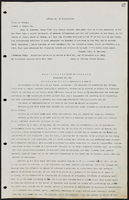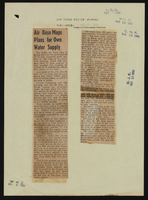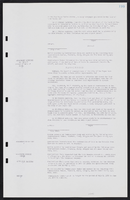Search the Special Collections and Archives Portal
Search Results
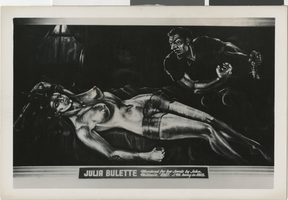
Postcard of Julia Bulette and John Millain scene, Virginia City, Nevada, 1867 - early 1900s
Date
1867 to 1939
Archival Collection
Description
An artist's depiction of Julia Bulette's theft and murder by John Millain. The caption on the front of the card reads: "Julia Bulette; Murdered for her Jewels by John Millain, 1887. J. M hung in 1868." A lengthy description printed on the back of the card reads: "Julia Bulette came to Virginia City while it was still a raw camp, and was soon among its best known figures. Reputedly a French Creole from New Orleans, tall, dark, lithe and witty, she was no ordinary lady of the line. Her secret charities were innumerable, her public services many, and her entertainments memorable for both cuisine and conversation. During the deadly black-water plague of 1861, she made her house into a hospital, nursed the stricken miners, and pawned her belongings to help their families. She was chosen an honorary member of Engine Company Number 1, but, not content with honorary status, attended the fires, worked a stirrup pump, and served refreshments to the Company afterwards. She was not one to seek obscurity or tolerate condescension. In the flush years of the first boom, she paraded C Street daily in a coach with four aces fanned upon the door, and sat nightly in her own box at the opera house, with a sable cape across her shoulders. When the ladies of the upper city sought to confine her activities, she retaliated by crashing their parties and making them her own. As a result, her violent death during the night of January 20, 1867, precipitated a cold war of the sexes. When her funeral procession, long, entirely masculine, and led by a band playing a dead-march, moved out B Street toward Old Flowery Cemetery, the wives in the hill mansions sat behind closed doors and drawn shutters, though even those could not defend them from the sprightly, returning strains of "The Girl I Left Behind Me." And conversely, when John Millain was arrested, some months later, after selling articles recognized as Julie's, his trial by the men was something less than impartial, but he was constantly visited in prison by women who showered him with gifts and tears. That his hanging, in April of 1868, drew the largest crowd in Virginia's history to the hollow north of town where the gallows was erected, the women to the ringside seats and the men to the slopes behind them, was less a tribute to Millain himself than a result of the fact that he was dying as the murderer of Julie Bulette, more nearly a Queen of the Comstock than any of her wealthy "betters" who vied for the title. "Sazarac" Virginia City, Nevada."
Image
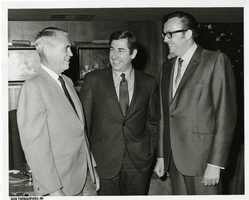
Photograph of Mayor Oran K. Gragson, Alaska Senator Mike Gravel, and John H. Meier of the Hughes-Nevada Corporation, April 13, 1969
Date
1969-04-13
Archival Collection
Description
Pictured L-R: Las Vegas Mayor Oran K. Gragson, U. S. Alaska Senator Mike Gravel, and John H. Meier of the Hughes-Nevada Corporation. The location where the photograph was taken is unknown. Two paintings are visible on the wall behind the men, and a table setting is visible behind Oran K. Gragson. The location where the photograph was taken is unknown. Oran Kenneth Gragson (February 14, 1911 – October 7, 2002) was an American businessman and politician. He was the longest-serving mayor of Las Vegas, Nevada, from 1959 to 1975. Gragson, a member of the Republican Party, was a small business owner who was elected Mayor on a reform platform against police corruption and for equal opportunity for people of all socio-economic and racial categories. Gragson died in a Las Vegas hospice on October 7, 2002, at the age of 91. The Oran K. Gragson Elementary School located at 555 N. Honolulu Street, Las Vegas, NV 89110 was named in his honor. Maurice Robert "Mike" Gravel (born May 13, 1930) is a former Democratic United States Senator from Alaska, who served two terms from 1969 to 1981, and a candidate in the 2008 U.S. presidential election. He served in the Alaska House of Representatives from 1963 to 1966 and also became Speaker of the Alaska House. Gravel was elected to the U.S. Senate in 1968. John H. Meier (born September 28, 1933) is an American financier and business consultant now living in Vancouver, Canada. He is noted for his involvement with Howard Hughes, his behind-the-scenes involvement in events that precipitated President Richard M. Nixon's resignation, and his work in the environment. During the Watergate hearings, one man wanted to tell a spellbound nation secrets about the Nixon White House, the CIA and Howard Hughes. He could have told them why the burglary happened, but that was not what the Committee wanted to hear. To keep him from telling his secrets, he was persecuted, jailed and forced into exile in Canada. Investigative reporter Gerald Bellett detailed everything in a book called Age of Secrets. In a revised edition for the first time is an excerpt from John Meier's diary on the Robert F. Kennedy Assassination. John Meier is the first person to reveal everything from the Hughes Organization, and Robert Maheu’s, involvement with the assassination, to Thane Cesar ’s connection to Jack Hooper.
Image
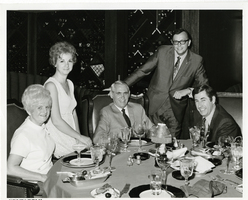
Photograph of Mayor Oran K. Gragson and his wife Bonnie enjoying dinner at the Frontier Hotel and Casino, Las Vegas, Nevada, April 13, 1969
Date
1969-04-13
Archival Collection
Description
Dining at the Frontier Hotel, April 13, 1969. Pictured L-R: Mrs. Bonnie Gragson, Mrs. John Meier, Las Vegas Mayor Oran K. Gragson, John Meier, U. S. Alaska Senator Mike Gravel. The location where the photograph was taken is unknown. Oran Kenneth Gragson (February 14, 1911 – October 7, 2002) was an American businessman and politician. He was the longest-serving mayor of Las Vegas, Nevada, from 1959 to 1975. Gragson, a member of the Republican Party, was a small business owner who was elected Mayor on a reform platform against police corruption and for equal opportunity for people of all socio-economic and racial categories. Gragson died in a Las Vegas hospice on October 7, 2002, at the age of 91. The Oran K. Gragson Elementary School located at 555 N. Honolulu Street, Las Vegas, NV 89110 was named in his honor. Maurice Robert "Mike" Gravel (born May 13, 1930) is a former Democratic United States Senator from Alaska, who served two terms from 1969 to 1981, and a candidate in the 2008 U.S. presidential election. He served in the Alaska House of Representatives from 1963 to 1966 and also became Speaker of the Alaska House. Gravel was elected to the U.S. Senate in 1968. John H. Meier (born September 28, 1933) is an American financier and business consultant now living in Vancouver, Canada. He is noted for his involvement with Howard Hughes, his behind-the-scenes involvement in events that precipitated President Richard M. Nixon's resignation, and his work in the environment. During the Watergate hearings, one man wanted to tell a spellbound nation secrets about the Nixon White House, the CIA and Howard Hughes. He could have told them why the burglary happened, but that was not what the Committee wanted to hear. To keep him from telling his secrets, he was persecuted, jailed and forced into exile in Canada. Investigative reporter Gerald Bellett detailed everything in a book called Age of Secrets. In a revised edition for the first time is an excerpt from John Meier's diary on the Robert F. Kennedy Assassination. John Meier is the first person to reveal everything from the Hughes Organization, and Robert Maheu’s, involvement with the assassination, to Thane Cesar ’s connection to Jack Hooper.
Image
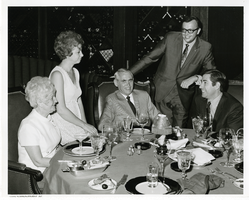
Photograph of Mayor Oran K. Gragson and his wife Bonnie enjoying dinner at the Frontier Hotel and Casino, Las Vegas, Nevada, April 13, 1969
Date
1969-04-13
Archival Collection
Description
Dining at the Frontier Hotel, April 13, 1969. Pictured L-R: Mrs. Bonnie Gragson, Mrs. John Meier, Las Vegas Mayor Oran K. Gragson, John Meier, U. S. Alaska Senator Mike Gravel. The location where the photograph was taken is unknown. Oran Kenneth Gragson (February 14, 1911 - October 7, 2002) was an American businessman and politician. He was the longest-serving mayor of Las Vegas, Nevada, from 1959 to 1975. Gragson, a member of the Republican Party, was a small business owner who was elected Mayor on a reform platform against police corruption and for equal opportunity for people of all socio-economic and racial categories. Gragson died in a Las Vegas hospice on October 7, 2002, at the age of 91. The Oran K. Gragson Elementary School located at 555 N. Honolulu Street, Las Vegas, NV 89110 was named in his honor. Maurice Robert "Mike" Gravel (born May 13, 1930) is a former Democratic United States Senator from Alaska, who served two terms from 1969 to 1981, and a candidate in the 2008 U.S. presidential election. He served in the Alaska House of Representatives from 1963 to 1966 and also became Speaker of the Alaska House. Gravel was elected to the U.S. Senate in 1968. John H. Meier (born September 28, 1933) is an American financier and business consultant now living in Vancouver, Canada. He is noted for his involvement with Howard Hughes, his behind-the-scenes involvement in events that precipitated President Richard M. Nixon's resignation, and his work in the environment. During the Watergate hearings, one man wanted to tell a spellbound nation secrets about the Nixon White House, the CIA and Howard Hughes. He could have told them why the burglary happened, but that was not what the Committee wanted to hear. To keep him from telling his secrets, he was persecuted, jailed and forced into exile in Canada. Investigative reporter Gerald Bellett detailed everything in a book called Age of Secrets. In a revised edition for the first time is an excerpt from John Meier's diary on the Robert F. Kennedy Assassination. John Meier is the first person to reveal everything from the Hughes Organization, and Robert Maheu’s, involvement with the assassination, to Thane Cesar ’s connection to Jack Hooper.
Image
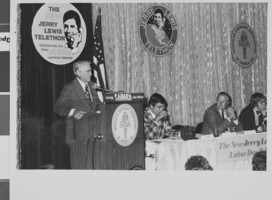
Photograph of Mayor Oran K, Gragson speaking at the pre-telethon production meeting, Las Vegas, Nevada, 1974
Date
1974
Archival Collection
Description
Las Vegas Mayor Oran K. Gragson (at the podium) addressing the general session at the pre-telethon production meeting for the Jerry Lewis Muscular Dystrophy Telethon at the Sahara Hotel and Casino. Oran Kenneth Gragson (February 14, 1911 – October 7, 2002) was an American businessman and politician. He was the longest-serving mayor of Las Vegas, Nevada, from 1959 to 1975. Gragson, a member of the Republican Party, was a small business owner who was elected Mayor on a reform platform against police corruption and for equal opportunity for people of all socio-economic and racial categories. Gragson died in a Las Vegas hospice on October 7, 2002, at the age of 91. The Oran K. Gragson Elementary School located at 555 N. Honolulu Street, Las Vegas, NV 89110 was named in his honor. The Jerry Lewis MDA Labor Day Telethon was an annual telethon held each Labor Day in the United States to raise money for the Muscular Dystrophy Association (MDA). The show was founded and hosted by actor and comedian Jerry Lewis, who hosted the broadcast from its 1966 inception until 2010. The history of MDA's telethon dated back to the 1950s, when the Jerry Lewis Thanksgiving Party for MDA raised funds for the organization's New York City area operations. The telethon was held annually on Labor Day weekend beginning in 1966, and would raise $2.45 billion for MDA from its inception through 2009. The telethon aired up to 21½ hours, starting on the Sunday evening preceding Labor Day and continuing until late Monday afternoon on the holiday itself. MDA called its network of participating stations the "Love Network". The show originated from Las Vegas for 28 of the years it was broadcast. Beginning in 2011, coinciding with Lewis's controversial departure, MDA radically reformatted and shortened the telethon's format into that of a benefit concert, shortening the length of the special each successive year. Successive telethons from 2012 to 2014 renamed the show as the MDA Show of Strength and further cut its airtime. The 2012 edition was reduced to three hours as a primetime-only broadcast. The 2012 edition did not refer itself as a "telethon". The 2013 Show of Strength discontinued the long-standing format of being syndicated to individual stations of varying network affiliation and aired on a major national network instead of being syndicated to individual stations, airing on ABC on Sunday, September 1, 2013, and being reduced to two hours. While the 2012 edition did not refer itself as a "telethon", it referred itself as such for the 2013 edition. The final edition, for 2014, aired on ABC on August 31, again as a two-hour special beginning at 9PM ET/PT. This was the final edition for the telethon, as it was announced on May 1, 2015 that the MDA would be discontinuing the annual event.
Image
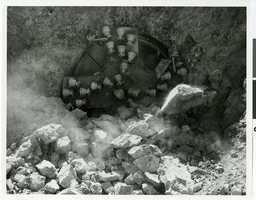
Photograph of the "Mole" Jarva Tunnel Borer breaking through the tunnel on the Las Vegas River Mountain Project, Las Vegas, Nevada, circa 1968-1971
Date
1968 to 1971
Archival Collection
Description
Another shot of the "mole" Jarva Tunnel Borer poking its nose out of the tunnel through mountain as work on the Las Vegas River Mountains Project progresses. The first stage of construction was completed between 1968-1971, and is comprised of a main aqueduct, a 3.78 mile tunnel through the River Mountains, eight pumping plants, and 31.4 miles of pipeline. This stage has a peaking capacity of 26.7 million cubic feet of potable water per day. The second stage enlarged the first stage system by expanding some of the existing facilities. New features included five pumping plants, the second barrel to the main aqueduct, and about 30 miles of pipeline and laterals with surge tanks, regulating tanks, and other delivery facilities. In conjunction with this stage, the State of Nevada enlarged and modified the Alfred Merritt Smith water treatment facilities to accommodate additional water supplies. The River Mountains Tunnel was constructed to full capacity in the first stage, and the Saddle Island intake facilities were oversized to accommodate both stages. The aqueduct system has a peaking capability of 53.4 million cubic feet of water per day. The River Mountains Tunnel was constructed during the first stage to accommodate second stage expansion. It is 3.78 miles long and was excavated through the River Mountains, which lie between Las Vegas Valley and Lake Mead. The concrete-lined tunnel has an inside diameter of 121.5 inches, and a maximum capacity of 608 cfs. The SNWA also constructed a larger tunnel, parallel to the River Mountains Tunnel for further expansion. The River Mountains Tunnel is used to convey raw water from Lake Mead to the River Mountains Water Treatment Facility that SNWA constructed near Henderson, NV. The River Mountains Facility, which began delivering treated water in October 2002, treats up to 300 million gallons of water per day, and was designed so it can expand to meet Southern Nevada's needs. In the future, the River Mountains facility will be able to treat up to 600 million gallons of water a day. This facility provides additional reliability and capacity to Southern Nevada's municipal water treatment and distribution capabilities.
Image
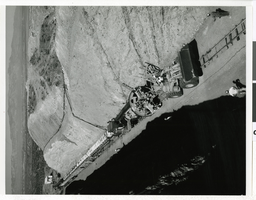
Photograph of the 988 caterpillar loader towing mole and conveyor to the tunnel portal used on the Las Vegas River Mountain Project, Las Vegas, Nevada, circa 1968-1971
Date
1968 to 1971
Archival Collection
Description
A front view taken from above of the outlet portal showing the 988 caterpillar loader towing mole and conveyor to the tunnel portal. The first stage of construction was completed between 1968-1971, and is comprised of a main aqueduct, a 3.78 mile tunnel through the River Mountains, eight pumping plants, and 31.4 miles of pipeline. This stage has a peaking capacity of 26.7 million cubic feet of potable water per day. The second stage enlarged the first stage system by expanding some of the existing facilities. New features included five pumping plants, the second barrel to the main aqueduct, and about 30 miles of pipeline and laterals with surge tanks, regulating tanks, and other delivery facilities. In conjunction with this stage, the State of Nevada enlarged and modified the Alfred Merritt Smith water treatment facilities to accommodate additional water supplies. The River Mountains Tunnel was constructed to full capacity in the first stage, and the Saddle Island intake facilities were oversized to accommodate both stages. The aqueduct system has a peaking capability of 53.4 million cubic feet of water per day. The River Mountains Tunnel was constructed during the first stage to accommodate second stage expansion. It is 3.78 miles long and was excavated through the River Mountains, which lie between Las Vegas Valley and Lake Mead. The concrete-lined tunnel has an inside diameter of 121.5 inches, and a maximum capacity of 608 cfs. The SNWA also constructed a larger tunnel, parallel to the River Mountains Tunnel for further expansion. The River Mountains Tunnel is used to convey raw water from Lake Mead to the River Mountains Water Treatment Facility that SNWA constructed near Henderson, NV. The River Mountains Facility, which began delivering treated water in October 2002, treats up to 300 million gallons of water per day, and was designed so it can expand to meet Southern Nevada's needs. In the future, the River Mountains facility will be able to treat up to 600 million gallons of water a day. This facility provides additional reliability and capacity to Southern Nevada's municipal water treatment and distribution capabilities.
Image
Pagination
Refine my results
Content Type
Creator or Contributor
Subject
Archival Collection
Digital Project
Resource Type
Year
Material Type
Place
Language
Records Classification

